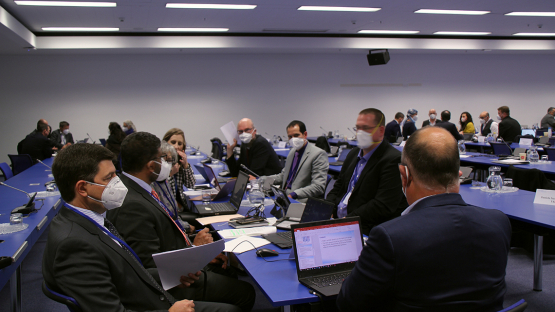Maintaining a strong pool of experts to support the IAEA’s Integrated Regulatory Review Service (IRRS) missions was the key objective of an IRRS training course hosted recently at IAEA headquarters. IRRS missions contribute to nuclear safety by providing an independent and thorough review of national regulatory frameworks across the globe.
“The interactive scenarios designed to simulate the process and activities of an IRRS mission, the role of IAEA safety standards in identifying and formulating observations, how to conduct interviews and review documentation were among the key areas that the training course provided,” said Anna Hajduk Bradford, Director of the IAEA’s Division of Nuclear Installation Safety. “This well-integrated capacity building effort enabled participants to have a comprehensive understanding of what an IRRS mission involves in ensuring safety at nuclear facilities.”
Thirty-eight experts from nuclear and radiation safety regulatory bodies from 29 countries received practical guidance and training on participating in an IAEA IRRS review.
The course provided staff from regulatory bodies, who may not be fully familiar with the IRRS process, with hands-on training about the preparation and the conduct of such missions. Discussions also focused on the specific roles and responsibilities of the IRRS mission reviewers as well as on the integrated approach to the review of common aspects of a country’s national legal and governmental framework and regulatory infrastructure for both nuclear and radiation safety. “The participants who successfully completed the training course will likely be invited to take part as reviewers in future IRRS missions,” said Bradford.
IRRS is designed to help countries strengthen and enhance the effectiveness of their governmental, legal and regulatory framework for nuclear, radiation, radioactive waste and transport safety, using the relevant IAEA safety standards as a basis. Its methodology includes a peer review for both technical and policy issues. IRRS missions aim to support countries in integrating regulatory requirements into national infrastructure and advancing the effective independence of regulatory authorities.
During the practical exercises, the participants were given guidance on the kind of information that should be provided as recommendations and suggestions to the host country for further enhancing nuclear and radiation safety regulatory oversight. A session on IRRS Mission Report writing involved discussion of highlighting good practices to improve safety.
Participants learned that in advance of an IRRS mission, the IAEA and the host country agree on the scope of the mission, including by defining which types of regulated facilities and activities will be included. “The review missions help assess national regulatory functions pertaining to multiple activities, including regulation of radiation safety, transport safety, nuclear security for controlled material and emergency preparedness,” said Bradford.
The interactive nature of the course included simulations of interviews with host country counterparts, team meetings, the formulation of observations and the drafting of a mission report, all of which gave participants a comprehensive understanding of the various aspects of an IRRS mission.








